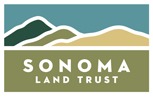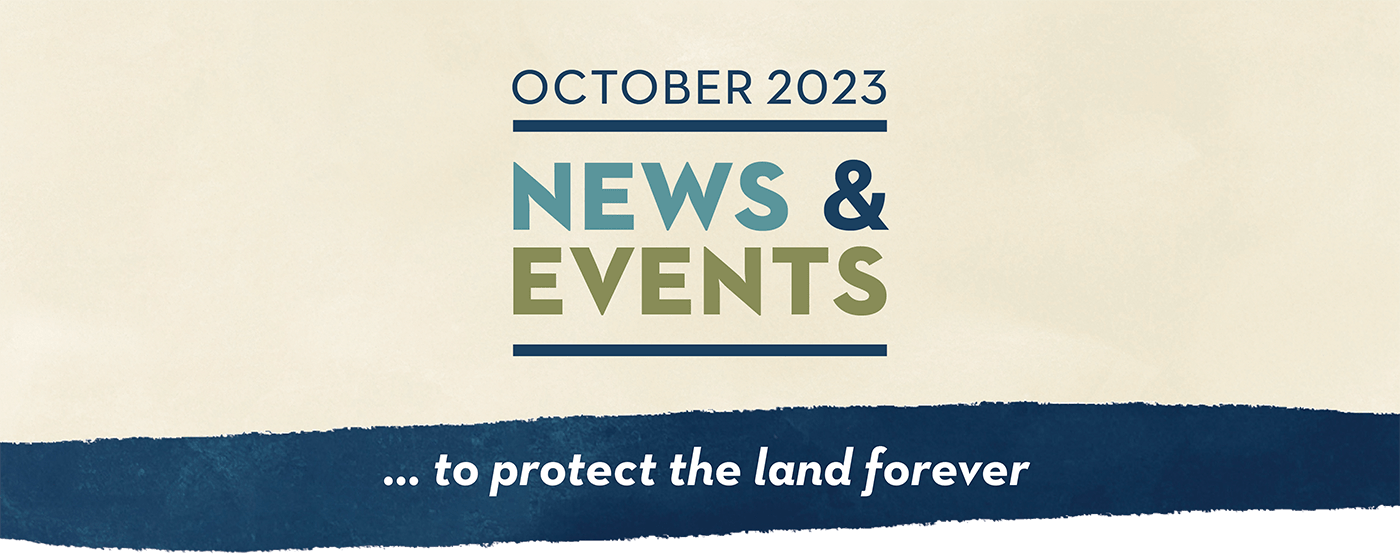
When we care for the land, it will care for us
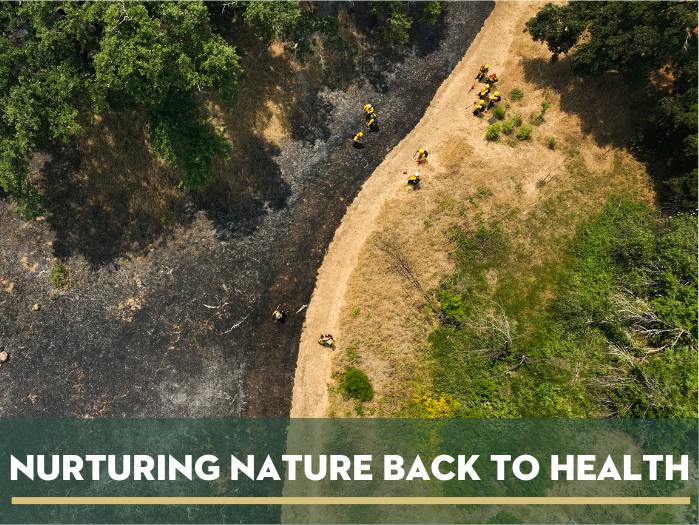
Our conservation work begins with the acquisition of a property, and when this highly vetted and rigorous process is complete, the land is primed for its most transformative phase – restoration. Not all properties come to us in great need of rehabilitation, however each has special circumstances that require a tailored care plan customized to meet its needs. Our team of experts spend numerous hours observing the land and its features, the natural resources and wildlife habitat, as well as its function for the community. The land stewardship team approaches their work in a way that is similar to a medical professional, looking holistically at a patient’s health and implementing care plans that focus on ensuring long-term well-being. Land stewardship is described as an ethical approach to land management that considers the cultural, social, equitable, and economic aspects of land use, encouraging natural processes in a sustainable manner. This adaptive management approach can dramatically shape how an ecosystem functions, which is important to all of us as we know that when we care for the land, the land will care for us!
Land restoration and management plans are based on the best and most recent scientific information available to manage our treasured landscapes. Land stewards collaborate closely with landowners, organizational partners, and communities to identify projects that over time, will ensure the land will remain healthy for future generations. This work is forward-looking – not only is our team solving the problems of today, but thinking ahead to the next challenge on the horizon to ensure that Sonoma County is resilient in the face of a changing climate.
We pursue projects across the county, and each of our stewardship staff has a region they specialize in; the coastal bluffs and prairies for example require different tactics than the flowing currents of the Russian River watershed or the tidal marshes of the bay. Each practitioner knows their region intimately, with multiple seasons (and decades) of learning the unique characteristics of the land. With the help of partner science and monitoring programs, they can follow the progress their plans are making by testing soils, counting wildlife populations, and tracking the return of native species.
The stewardship teams’ accomplishments in 2023 are too many to list, but a few highlights include:
- The first prescribed burns at our Little Black Mountain and Pole Mountain coastal preserves.
- A second annual prescribed burn at our Glen Oaks Ranch and Laufenburg preserves.
- The implementation of the Bay Area’s first Stage Zero creek restoration on our Sears Point preserve.
- The restoration of a 140-year-old barn on our Laufenburg Ranch preserve.
- An extensive restoration on the Drake conservation easement property, which included decommissioning and restoring an illegally constructed road and the planting of over sixty live oak trees.
We are incredibly fortunate to have this team of dedicated and skilled land stewards and we invite you to explore more of their work on our website and through updates on our social media channels.
Cuando cuidamos la tierra, ella nos cuidará
Nuestro trabajo de conservación comienza con la adquisición de una propiedad y, una vez completado este proceso tan examinado y riguroso, el terreno está preparado para su fase más transformadora: la restauración. No todas las propiedades llegan a nosotros con una gran necesidad de rehabilitación, sin embargo cada una tiene circunstancias especiales que requieren un plan de cuidados personalizado para satisfacer lo que necesita. Nuestro equipo de expertos pasa numerosas horas observando la tierra y sus características, los recursos naturales y el hábitat de la vida silvestre, así como su función para la comunidad. El equipo de gestión y protección de la tierra enfoca su trabajo de forma parecida a un profesional de la medicina, considerando de forma holística la salud de un paciente y aplicando planes de atención centrados en garantizar el bienestar a largo plazo. La gestión y protección de la tierra se describe como un enfoque ético de manejo de la tierra que tiene en cuenta los aspectos culturales, sociales, equitativos y económicos del uso del terreno, fomentando los procesos naturales de forma sostenible. Este enfoque de manejo adaptativo puede influir enormemente el funcionamiento de un ecosistema, lo cual es importante para todos nosotros, pues sabemos que cuando cuidamos la tierra, ¡la tierra nos cuidará!
Los planes de restauración y manejo de la tierra se basan en la mejor y más reciente información científica disponible para gestionar nuestros preciados paisajes. Los gestores y protectores de tierras colaboran de cerca con los propietarios, los socios de las organizaciones y las comunidades para identificar proyectos que, con el tiempo, garanticen que la tierra permanecerá sana para las futuras generaciones. Este trabajo está orientado hacia el futuro: nuestro equipo no sólo resuelve los problemas actuales, sino que también piensa en el próximo reto del futuro inmediato para garantizar que el condado de Sonoma sea resistente ante un clima cambiante.
Llevamos a cabo proyectos en todo el condado. Cada miembro de nuestro personal de gestión y protección tiene una región en la que está especializado; los acantilados costeros y las praderas, por ejemplo, requieren planes de acción diferentes que las corrientes fluidas de la cuenca del río Ruso o las marismas mareales de la bahía. Cada profesional conoce profundamente su región, con múltiples temporadas (y décadas) de aprendizaje de las características únicas de la tierra. Con la ayuda de programas científicos y de monitoreo asociados, pueden seguir los progresos de sus planes analizando los suelos, contando las poblaciones de vida silvestre y observando el regreso de las especies autóctonas.
En 2023, los logros de los equipos de gestión y protección son demasiados para enumerar todos, pero algunos de los más destacados son:
- Las primeras quemas controladas en nuestras reservas costeras de Little Black Mountain y Pole Mountain.
- Una segunda quema controlada en nuestras reservas de Glen Oaks Ranch y Laufenburg.
- La puesta en marcha de la primera restauración de un arroyo en Fase Cero del Área de la Bahía en nuestra reserva de Sears Point.
- La restauración de un granero de 140 años en nuestra reserva de Laufenburg Ranch.
- Una extensa restauración en la propiedad de servidumbre de conservación de Drake, que incluyó el desmantelamiento y la restauración de un camino ilegalmente construido y la plantación de más de sesenta robles vivos.
Somos increíblemente afortunados de contar con este equipo de dedicados y hábiles gestores y protectores de la tierra. Te invitamos a explorar más de este trabajo en nuestro sitio web y a través de las actualizaciones en nuestras redes sociales.
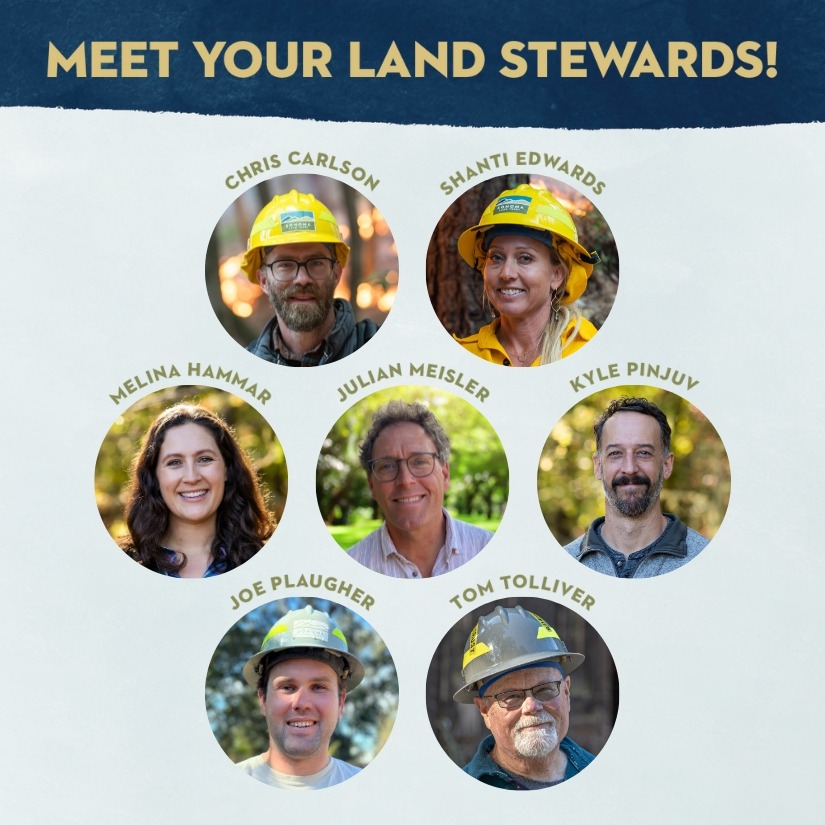
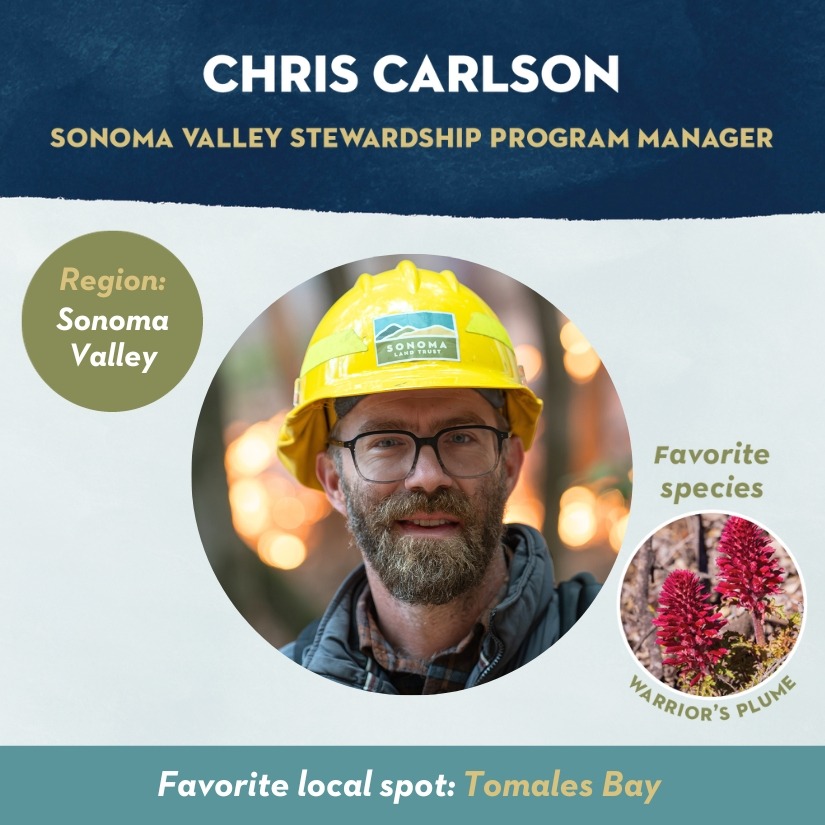
Chris Carlson – Sonoma Valley Stewardship Program Manager
Chris manages our Sonoma Valley preserves, including the historic Glen Oaks Ranch, and has nearly two decades of conservation experience. He also leads our living with fire program, which restores forest health through the practice of good fire. Chris applies his fire ecology expertise to the planning of future forest management projects on our preserves across the county, and educates landowners on the benefits of good fire, building climate resilience in our communities. Chris knew he found his calling his junior year of college, when he spent six months measuring forest vegetation in Idaho and was hooked on fieldwork despite the long hours and laborious attention to detail. In the years since, he has earned his MS in Forestry and worked across the Western United States monitoring and studying natural resources, including wildfire response to thinning in the Sierra Nevada, and restoration project management in the Sacramento delta region.
Fun fact: Chris is a fungi forager and brewer of fruit wines.
Favorite species: Warrior’s Plume

Shanti Edwards – Sonoma Coast Senior Project Manager
Shanti has lived in Sonoma County for over 25 years and has been at the land trust for 19 of them! She manages our coastal preserves and holds a deep love of the land, sharing that a highlight of her career was living on the Jenner Headlands, becoming attuned to the sound of coyotes, a great horned owl family, and territories of hawks. Shanti’s land management projects address the specific needs of post-fire and industrial logging era forested landscapes, as well as utilizing agricultural grazing practices as a tool to promote native grassland vegetation and reduce fine fuels. Among the preserves she manages are pristine coastal prairie habitats that boast a variety of native perennial bunchgrasses and wildflowers that are unique to the region. Through collaborations with partner organizations, agricultural producers, private foundations, neighbors, and volunteers, Shanti nurtures human relationships much like she approaches the land and has gained the trust of our closest partners. This year, Shanti organized the return of prescribed fires on our coastal preserves in partnership with CAL FIRE and says she is inspired by the ability of low-intensity fire to transform the landscape and safely reduce fuel loading in densely wooded forests.
Fun fact: Shanti lived on the Jenner Headlands for eight years. (And knows where the best wild raspberries are!)
Favorite species: Osprey
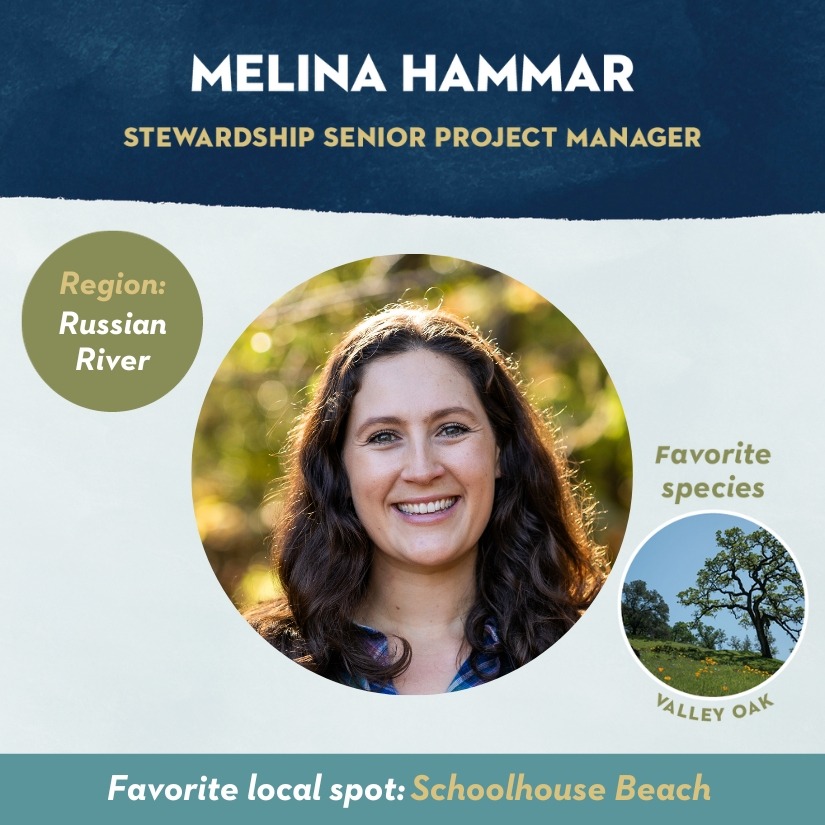
Melina Hammar – Stewardship Senior Project Manager
Melina manages our preserves in the Russian River watershed, where her work is focused on forest management, fire resilience, and securing freshwater flows. Her time spent exploring the expansive East Bay hills as a child helped to foster her love of the outdoors and spurred her conservation career nearly a decade ago. Melina got her start as an intern for Sonoma Land Trust, working on the Sonoma Valley Wildlife Corridor and conducting grassland monitoring on the coast to help inform scientific research – these experiences solidified her passion for land conservation. She went on to work for other local conservation organizations and agencies, assisting landowners with resource conservation planning and land stewardship, but then returned to Sonoma Land Trust, “where it all began!”
Fun fact: Melina is an avid gardener and seed saver.
Favorite species: Valley Oak
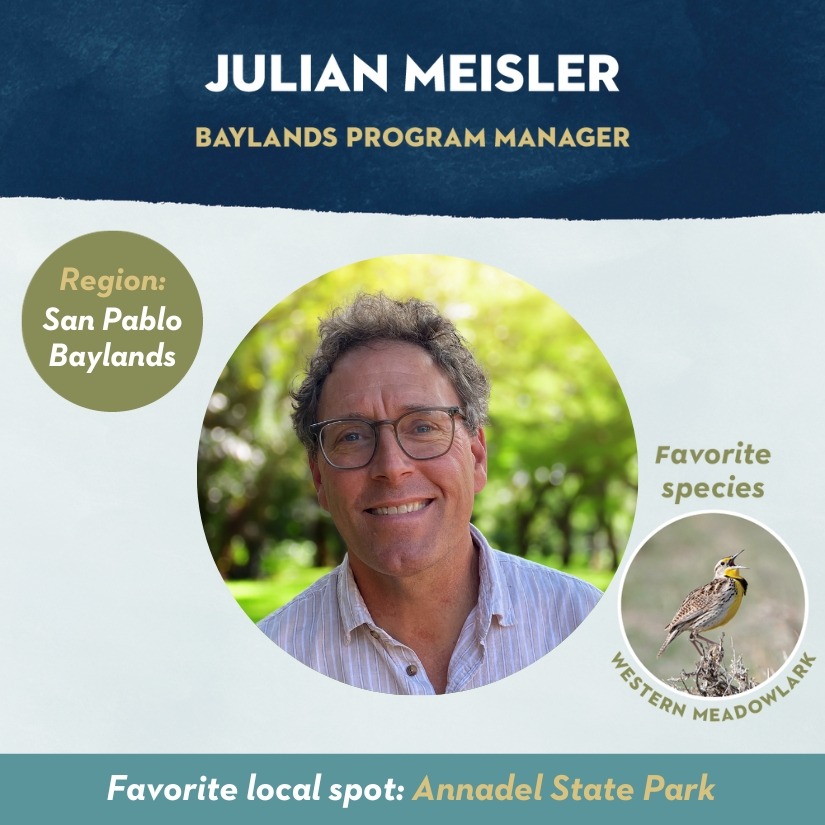
Julian Meisler – Baylands Program Manager
Julian’s expertise focuses on an area of Sonoma County that is unfamiliar to most who live here – the Baylands! He knew at a young age that he wanted to work in the environmental field after completing a three-month wilderness course in Mexico just after high school. Nearly three decades later, with a BS in natural resources management and a MS in botany, he is the subject matter expert with a deep understanding of how to reconnect tidal and upland landscapes to accommodate future sea level rise. His program has restored over 1,000 acres in the Baylands to date, which includes returning a once-diked area to its former state after a momentous levee breach in 2015 that reopened water access – a project that has taken over a decade. Julian shares that restoration of tidal wetlands at scale is inspiring, “almost overnight the birds return by the thousands, and gradually so do many other species.” Due to the location of his work, he collaborates with partners in conservation, transportation, agriculture and, most notably, with the proposed elevated causeway of SR 37.
Fun fact: Julian was a traveling wildlife biologist and has studied lizards in Puerto Rico and been a wilderness ranger in Alaska.
Favorite species: Western meadowlark
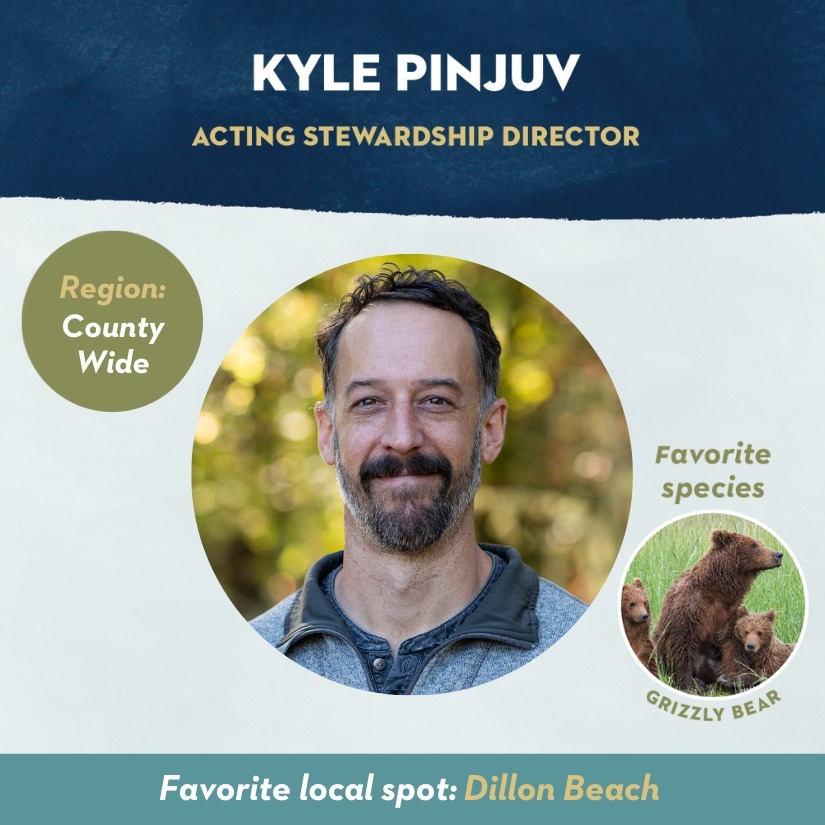
Kyle Pinjuv – Acting Stewardship Director and Conservation Easement Program Manager
Kyle manages our conservation easement properties which are not isolated in one region but spread out across the county with various habitats and natural resources to look after. He works closely with landowners to assist them in developing forest management and fire resiliency plans for their land. Kyle studied history in college but was inspired to change his career after a temporary position that had him removing invasive species in Washington state became impetus to learn more about the field. His graduate studies in the environmental field led him to work in a variety of locations, including Alaska (where he spent four years studying bears), New Mexico, and Maine before returning to the West Coast in 2015 to work for Sonoma Land Trust. Kyle has nearly twenty years of conservation experience and recently stepped into the acting stewardship director role.
Fun fact: Kyle has worked on a geoduck farm in Washington (a cousin of the Pacific oyster).
Favorite species: Grizzly bear
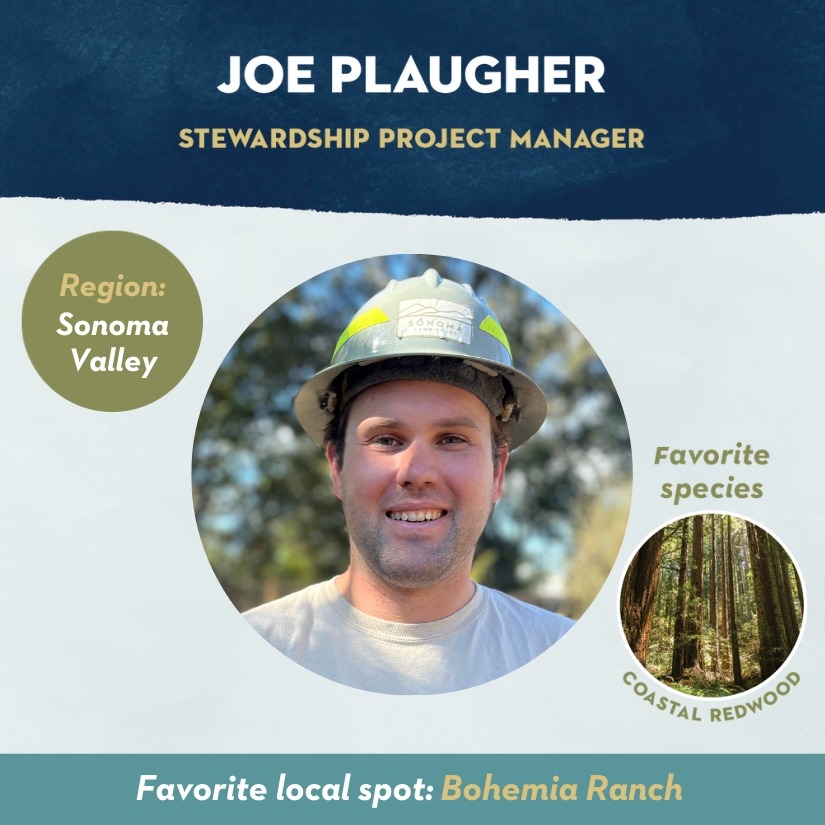
Joe Plaugher – Stewardship Project Manager
Joe is a Swiss-army knife with skills ranging from the most technical to the most mechanical and almost everything in-between. He stewards our Sonoma Valley preserves and coordinates the Sonoma Valley Wildlands Collaborative, a group of partner organizations that came together after the Nuns fire to improve ecosystem health, increase resilience to climate change, and reduce future impacts of wildfire to communities in the area. Joe is a Guerneville native who grew up among the redwoods, and after working in public policy entered the field of conservation through a volunteer opportunity on a prescribed burn with the Good Fire Alliance. He feels lucky to work on prescribed fire projects that restore ecosystem health in his own backyard.
Fun fact: Joe has hiked the full Pacific Crest Trail, and earned the nickname Lightning Rod for his height and quick hiking pace.
Favorite species: Coastal redwood
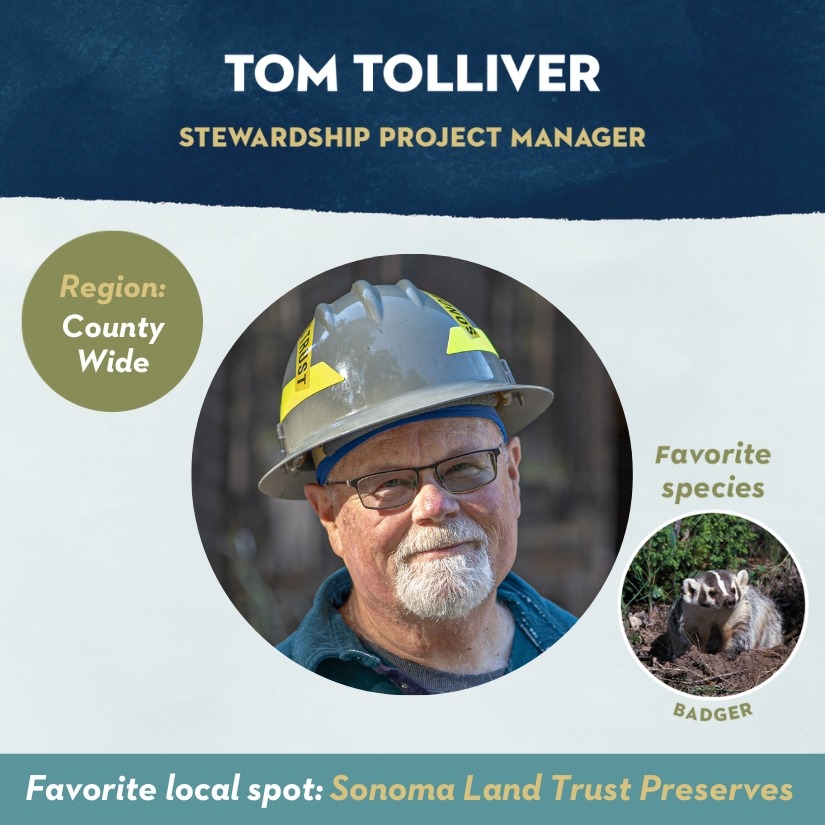
Tom Tolliver – Stewardship Program Manager
Tom’s relationship with Sonoma Land Trust began in 2010 as an independent contractor before finally signing on as a full-time employee shortly after the 2017 fires. Tom’s construction and project management skills are instrumental in projects that rebuild infrastructure on our preserves. Tom’s conservation career is rooted in a deep interest in wildlife and their habitats which was sparked by his early curiosity about birds. He began birding in high school, which led him to volunteering on conservation projects that taught him how to install wildlife water stations, and had him counting high desert deer and jack rabbits for the California Department of Fish and Game. Tom is currently overseeing the preservation of Laufenburg Ranch’s historic barn, built in 1883.
Fun fact: Tom’s first career was in youth development and after leading the construction of the local teen club, found his calling in project management.
Favorite species: Too many to name, but the badger is one.
Harold Appleton: A Lifetime of Stewardship

For Sonoma Land Trust, environmental stewardship is a driving force of our organization and part of everything we do – from conserving land to finding nature-based solutions for climate resilience to fostering the next generation of stewards through our educational programming.
For long-time volunteer, contractor, donor, and Professional Forester Harold Appleton, environmental stewardship has been the driving force of his entire life.
Harold credits one childhood experience in particular as igniting a spark in him. Growing up on Long Island, Harold and his friends loved playing in a nearby wetlands they called “the swamp,” even ice skating on it in the wintertime. Then one day, developers arrived and began paving over and building houses on the kids’ beloved swamp. To make it worse, the houses turned out to be structurally unsound, since they were built on unstable wetlands.
“I learned at a young age,” Harold explains, “how development can rob us of our ‘natural playgrounds.”
After attending UC Santa Cruz’s Environmental Studies program, Harold completed forestry school at UC Berkeley and began working in the Calaveras Big Trees State Park in the late 1970s, under the direction of a UC Berkeley Forestry professor emeritus named Harold Biswell.
“I was fortunate as a young man to get to work with Dr. Biswell,” Harold remembers. “At a time when it was a relatively rare practice, he was an early proponent of prescribed burning.” Harold recalls that Dr. Biswell’s teachings were similar to the traditional Indigenous practice of using ‘good fire’ as a tool for forest health. But back then, when fire suppression was the rule, Dr. Biswell came under a lot of criticism from fire professionals, foresters, and even fellow scientists and researchers who treated his ideas as being out of alignment with theirs. “Some even called him ‘Harry the Torch!’”
Though he couldn’t have known it at the time, the lessons Harold learned about ‘good fire’ from his mentor would come full circle much later in his life, including in the work he does today with Sonoma Land Trust.
While continuing to work as a forester, Harold launched a native plant nursery that he ran for 18 years, first in Mendocino and then relocating to Sonoma County. In the late 1980s, he began volunteering with Sonoma Land Trust as a monitor for the Land Trust’s Little Black Mountain property, periodically checking for signs of erosion and property line encroachment.
In the late 1990s, David Katz, the Land Trust’s executive director at the time, asked Harold if he would develop a forest management plan for Little Black Mountain, and so began another layer of Harold’s stewardship commitment to the Land Trust, this time as a professional contractor.
Through Harold’s leadership, Sonoma Land Trust has implemented a multitude of projects over the years addressing forest and wildland fuel management, property infrastructure, erosion control, and trail development to ready our preserves for educational programs and recreational activities.
Then in 2017 came the catastrophic Nuns and Tubbs fires. Of course, Harold had seen many, many wildfires over his 40 years working in forestry, but nothing prepared him for the mega-fires that ripped through Sonoma County that year.
“We knew the forests were in a very dangerous state,” he recalls, referring to the high levels of fuel loads and years of drought. “But the severity of those fires surprised everyone – the fire behavior was like nothing we’d seen before.”
Yet in the aftermath of the disaster, Harold sees a silver lining in how landowners, CAL FIRE, the Land Trust, and its partners have all come together to implement prescribed burning and fuel management on a very serious level. In his four decades as a forester, employing ‘good fire’ as he’d done with his old mentor Dr. Biswell had never been an option. Harold remembers working on forest management plans with the Land Trust in the years leading up to 2017, wishing that prescribed burning could be a management practice.
“At the back of our minds, we wanted to do the prescribed burning, but there were just too many obstacles and legal considerations,” Harold says. “Now, legislation has been passed to do precisely that.”
Even as he eases into retirement, Harold plans to continue his involvement with Sonoma Land Trust. “The fact that the Land Trust takes land stewardship so seriously is huge – it’s what keeps me going with the organization. That and the people I’ve worked with here.” He calls out his relationships with former Director of Stewardship Bob Neale, and Melina Hammar and Shanti Edwards.
“Shanti has a way of keeping me engaged,” Harold explains, “always inviting me out to different projects, whether as a volunteer, a contractor, or just plain curiosity.”
One theory of environmental stewardship categorizes stewards into three roles: doers, donors, and practitioners. Harold Appleton is someone who embodies all three roles through his partnership with Sonoma Land Trust and in his lifelong dedication to stewardship.
Harold was interviewed by CAL FIRE’s Jason Clay October 9, 2023 during the first prescribed burn at Little Black Mountain – something he helped set the stage for 20 years ago. Watch this video to learn more about his thoughts on that historic day.
Survey
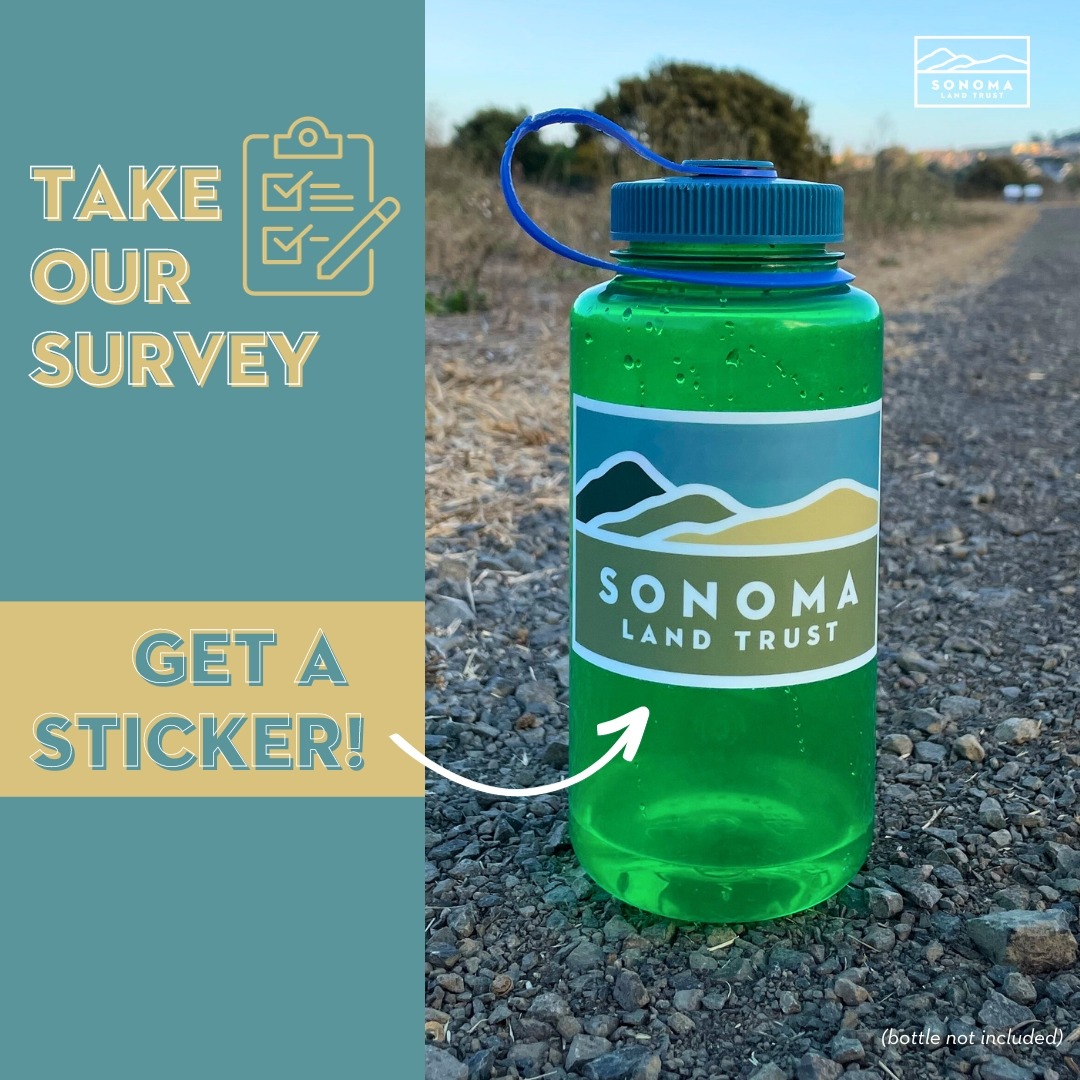
We want to hear from you! Please take our survey to tell us your interests, how you would like to be involved with our work, and how you think we’re doing. It’s easy to do, only occupies 10 minutes of your day, and your feedback truly matters to us! Please take and share the survey today
As a thank you gift, we will send you a Sonoma Land Trust sticker!
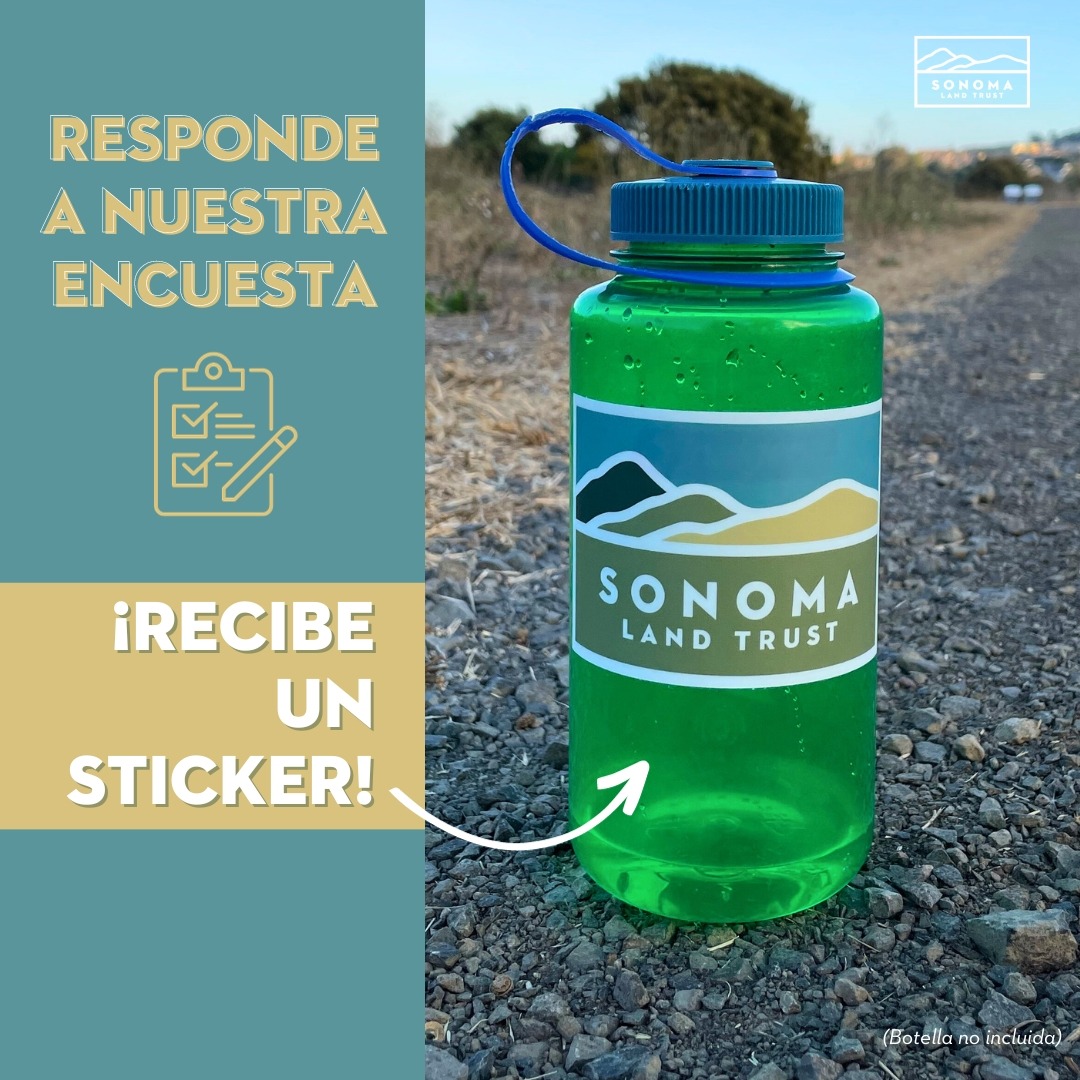
¡Queremos tus comentarios! Responde a nuestra encuesta para decirnos cuáles son tus intereses, cómo te gustaría participar en nuestro trabajo y cómo están yendo nuestros esfuerzos. Es fácil hacerlo, sólo ocupará 10 minutos de tu día, ¡y tu opinión nos importa de verdad! Por favor, realiza y comparte la encuesta hoy mismo.
Como regalo de agradecimiento, ¡te enviaremos un sticker de Sonoma Land Trust!
Events
Language of the Land: Ancient Forests of Sonoma County
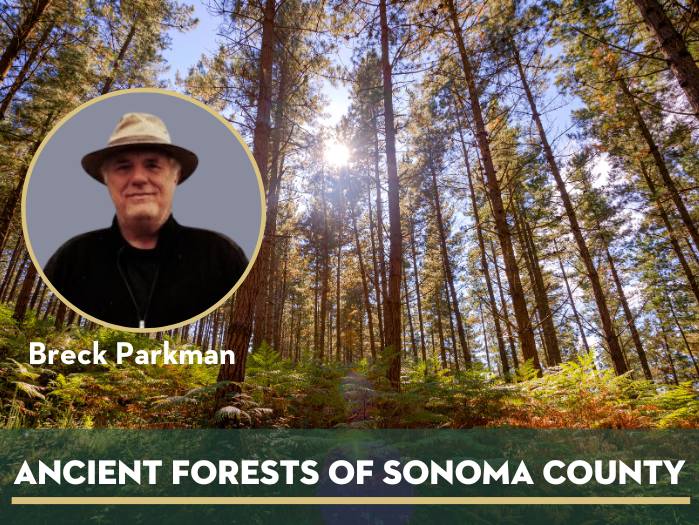
Language of the Land: Ancient Forests of Sonoma County
November 16, 7–8:30pm
The remains of ancient trees have been found at several locations in Sonoma County. In this talk, retired State Archaeologist Breck Parkman will discuss the nature of the ancient forests of Sonoma County and highlight two of his important discoveries. The first was a Sitka spruce at Bodega Head, remnants of which were exposed during a winter storm, and the second was a Monterey pine found eroding from Sonoma Creek. Both trees were many thousands of years old, dating to the last Ice Age. What might that mean in a world facing a changing climate?
Lenguaje de la tierra: Bosques antiguos del condado de Sonoma
16 de noviembre, 7–8:30 p.m.
Se han encontrado los restos de árboles antiguos en varios lugares del condado de Sonoma. En esta charla, Breck Parkman, arqueólogo estatal jubilado, destacará dos de sus importantes descubrimientos. El primero fue un abeto Sitka en Bodega Head, cuyos restos se presentaron tras una tormenta invernal. El segundo fue un pino Monterey, encontrado en un estado de descomposición en el arroyo Sonoma. Los dos tenían miles de años de edad y databan de la última glaciación. En esta charla, Breck Parkman hablará de la naturaleza de los bosques antiguos del condado de Sonoma y de la importancia de encontrar un abeto Sitka antiguo y un pino Monterey antiguo que crecía aquí durante los finales de la glaciación. ¿Qué podría significar eso en un mundo que se enfrenta a un clima cambiante?
Outings
Join us out in nature this month! We’ll be exploring the tidal marsh at Sears Point, hiking up Pole Mountain, watching raptors at Estero Americano, and more. Visit our outings page to learn more and register.
11/4/23 – Sears Point Marsh Walk
11/5/23 – Adventure Hike up Pole Mountain from Little Black Mountain
11/11/23 – Glen Oaks Ranch Walk
11/12/23 – Estero Americano Raptor Walk with Larry Broderick
11/18/23 – Familias al Aire Libre
Recommendations

- Book: Secrets of the Oak Woodlands by Kate Marianchild
- Podcast: Fellowship of Tree Rings Radiolab
- Video: Walk with Obi: The Coasts of California, Wildbound PR
- Webinar: Language of the Land: Gardening for Wildlife, Sonoma Land Trust
en Español - TED Talk: A Climate Solution That’s Right Under Our Feet, Asmeret Asefaz Berhe
- App: Plant Snap, plant identifier
